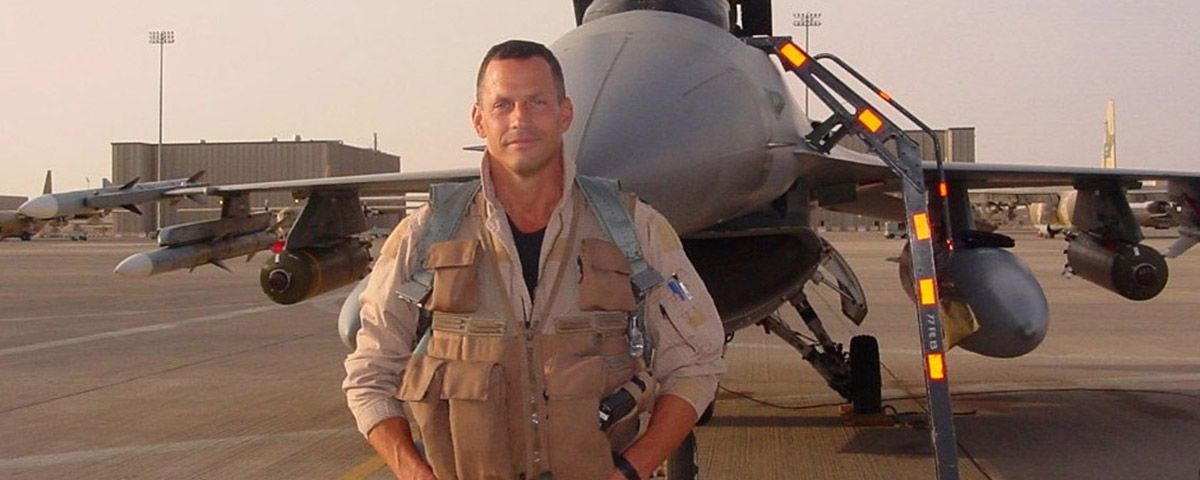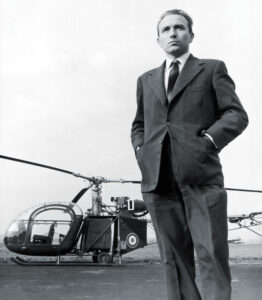An F-16 Wild Weasel pilot recounts a dangerous mission during Operation Iraqi Freedom in which he helped save a group of trapped Marines.
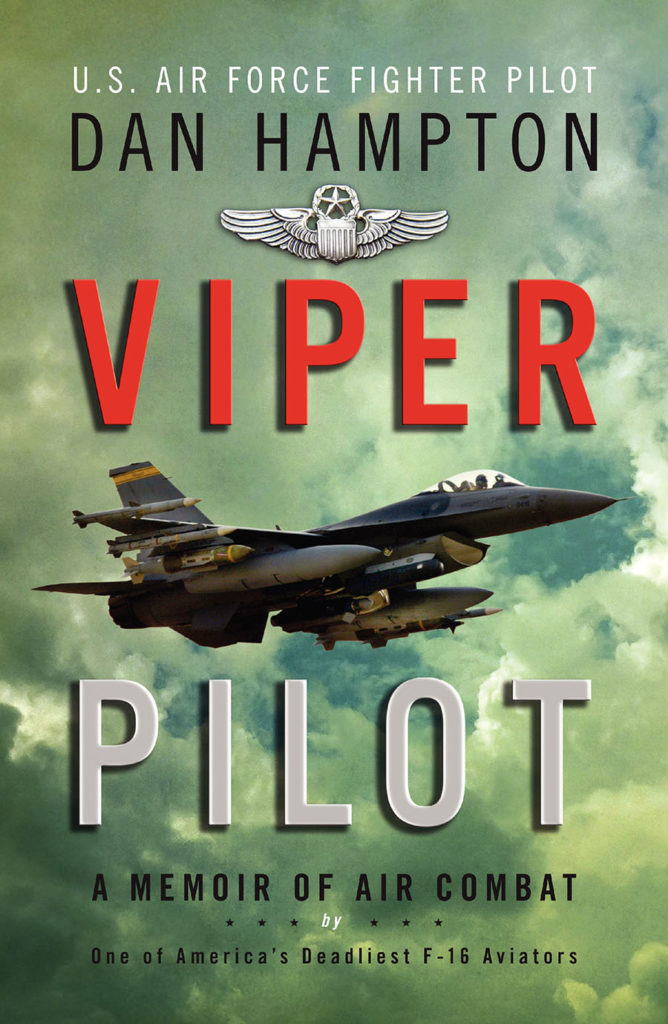 From the forthcoming book Viper Pilot: A Memoir of Air Combat by One of America’s Deadliest F-16 Aviators, by Dan Hampton. ©2012 Dan Hampton. To be published on October 2, 2012, by William Morrow, an imprint of HarperCollins Publishers. Reprinted by permission.
From the forthcoming book Viper Pilot: A Memoir of Air Combat by One of America’s Deadliest F-16 Aviators, by Dan Hampton. ©2012 Dan Hampton. To be published on October 2, 2012, by William Morrow, an imprint of HarperCollins Publishers. Reprinted by permission.
March 24, 2003, Nasiriyah, Iraq
“C’mon…c’mon…” I gritted my teeth. Forcing my aching jaws to relax, I pulled the throttle back farther and dropped the F-16’s nose a few degrees toward the ground. As the Viper slid down into the dusty brown mess below us, I felt unaccustomed anxious twinges jab through my gut.
“All Players, all Players…this is Luger on guard for emergency close air support. Any CAS-capable flights report to Luger on Indigo Seven…repeat—any CAS-capable flights report to Luger on Indigo Seven. Emergency CAS in progress. Luger out.”
I stared at the stack of mission materials on my knee. I’d never heard of Indigo Seven, but I had a comm card that was supposed to have every frequency in the galaxy on it for a given mission.
Another freq I don’t have. I swore at the idiots who’d done the mission planning in the six months before the war. They drank coffee, sat on their butts and generated an enormous amount of material, 90 percent of which was useless.
I knew some of them. Smart guys, but so utterly convinced they were correct that they’d failed to heed anyone else’s suggestions. The results spoke for themselves. I didn’t even have a decent large-scale map of Iraq, and no provision had been made at all for close air support missions. I was a Wild Weasel, a surface-to-air missile killer—close air support was not in our job description. But those of us who’d fought the First Gulf War or Kosovo knew better. When troops on the ground needed help, any fighter available was supposed to be there—fast.
FUEL…FUEL…the green symbol flashed in the center of my heads-up display (HUD). Toggling it off, I quickly typed in a new minimum fuel number. A much lower number. It might keep the warning signal from bothering me, but it wouldn’t put another pound of JP-8 in my fuel tanks. It was also a cardinal sin. If you didn’t have enough fuel to finish your mission, then you returned to base. Simple.
Or not.
The Second Gulf War was in its fifth day, and a unit of the 3rd Battalion, 2nd Marines had gotten cut off north of Nasiriyah in southern Iraq. They’d called for emergency close air support, which meant any fighters able to respond were to scratch their existing missions and race to the scene. It was literally life or death.
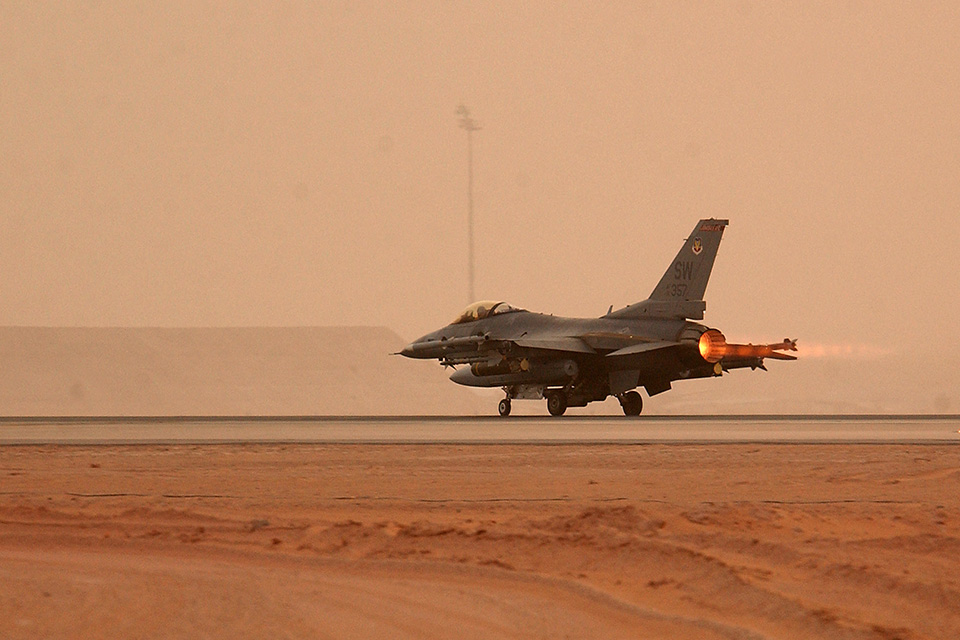
Operating under call sign Roman 75, my four-ship (a flight of four fighters) had been immediately rerolled to try to save the Marines. Unfortunately, the biggest sandstorm in recent history was headed this way, and two other flights of fighters had been unable to get down through the stuff and find the grunts.
So I wasn’t optimistic.
But this was war, and you did what you had to do.
“Roman…Roman…this is Chieftain…say…” Chieftain was the Marine unit that called for close air support. The crackling radio erupted with the unmistakable popping of automatic weapons in the background.
I swallowed, hard. I knew what he was asking. Where the hell are you? What’s taking so long? You’ve got to get here NOW or we’re all dead.
I licked my lips, feeling my tongue rasp over cracked skin that hadn’t tasted water in nearly eight hours. “Chieftain…Chieftain…Roman 75 is attacking from the south…60 seconds.”
Southern Iraq is ugly. No two ways about it. As I stared out over the vast Mesopotamian plain, I wondered, not for the first time, why we never seemed to go to war in pretty places. Lichtenstein or Ireland maybe. Bermuda.
Today it was just a tan mess. The jagged blue-green scar of the Euphrates River was muted, like someone had thrown a sheer brown cloth over it. Usually the earth east of the river, toward the Iranian border, looked green and relatively fertile. Now it was blanketed in shades of mud. The horizon worried me, since it had disappeared into a dirty-brown wall boiling up from the southwest, covering Iraq in an ominous haze. Farther west, the sky had turned a dull black from the ground up to 50,000 feet. The sun was a faded orange smear, barely visible through the curtain of sand.
I glanced around the cockpit again. Adjusting a setting here, rechecking one there. Along the right console, way in the back, I had a canvas bag about the size of a shoebox. This held the aircraft’s data cartridge and classified tapes. Once they were loaded, I used the bag for my water bottle, extra piddle packs and some food. I unzipped it so, hours later, I could get inside with one hand. I always looked forward to snack time. Sort of a reward for surviving.
My fighter dropped through 7,000 feet, and I stole one more look at the ominous sky around me. The sandstorm was almost here. The front edge of it had rolled up from the southwest, covering everything in a tan haze. I’d split off my number three and four aircraft and just kept my wingman orbiting above the target area. There was no need for both of us to be down here.
“Roman…Ro…”
There was panic in the forward air controller’s voice, and I fought back the nearly overwhelming urge to shove the nose forward and dive into the fight. I wouldn’t help them by getting myself killed. If I could see the ground, it would be different, but the dust made an immediate attack impossible.
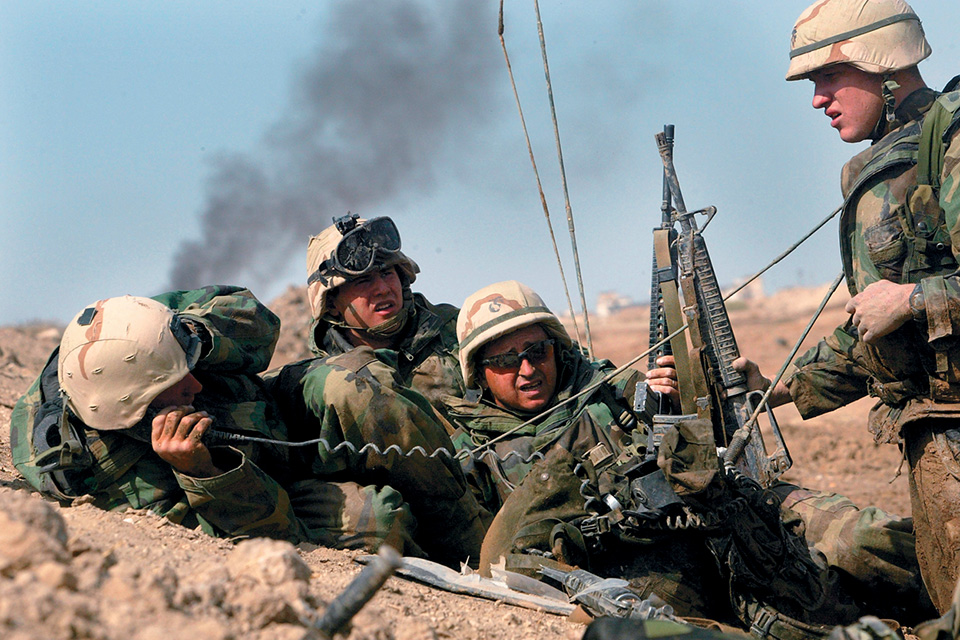
I keyed the mike and spoke clearly and unemotionally. I hoped a calm, confident voice would do them good, even if I hardly felt that way myself. Fighter pilots are great actors.
“Chieftain…confirm no friendlies are on the road. Repeat…confirm no friendlies are on the road.”
“Affirmative! Affirmative…all friendlies…road…west of the road…”
I zippered in reply, and as the dust swallowed the jet, I called up my air-to-ground weapons display and selected one of the two AGM-65G infrared Maverick missiles slung beneath my wings.
They were big. About 600 pounds each and able to precisely guide by tracking contrasts in the heat, or lack of heat, around a target.
“Sonofabitch…”
I was staring at my display, seeing what the Maverick saw, and it was crap. Completely washed out, like a TV station that had gone off the air in a cloud of brown static.
Four thousand feet…and five miles to the target. Not much time.
I quickly switched to the other missile. Same thing. “Bastard…”
The blowing sand wasn’t helping, but it wouldn’t do this much damage, and I thumped the glare shield in frustration. I’d been so busy that I’d forgotten that the sun was going down. IR missiles worked fine at night, because they basically tracked contrasts, not a visual picture. But for a few hours on either side of sunset or sunrise, everything was the same temperature unless it was heated internally. Called diurnal crossover, it was unavoidable, and it nearly always destroyed the infrared picture. This was exactly why we used other weapons during those times. But the only other tool I had was my cannon. That meant getting very low and very close.
But men were dying. Our men.
I strained forward against the ejection-seat harness and continued down.
Three thousand feet. Four hundred eighty knots and descending. I was riveted to my radar altimeter, which gave me a digital readout of my actual height above the ground. A lifesaver at night or in bad weather. Like now.
Maybe the dust will thin out lower down. I took a breath and ignored my thumping heart. It truly was hammering against my chest. No kidding.
“Roman…Roman…the Rags have crossed the road…they’re…they’re…stand by!”
“Rags” was politically incorrect shorthand for raghead. Meaning the Iraqi army, in this case. I tried to lick my lips again but gave up. Pulling the throttle farther back, I fanned my speed brakes to slow the F-16 down as it passed 2,000 feet.
There!
I blinked several times to make sure I wasn’t hallucinating. Darker brown. Rocks and the ugly, stunted green bushes that dotted Iraq. Ground!
Immediately staring forward through the HUD, I centered the steering cues toward the only position I’d been given.
3.3 miles.
With wide eyes, I quickly glanced at the radar warning receiver. Happily, it was empty of any signals from radar-guided missiles or anti-aircraft artillery. Of course, it wouldn’t pick up infrared missiles or the few hundred AK-47s down there, but I’d take what good news I could find.
Leveling the fighter at 1,000 feet, I closed the speed brakes and pushed the throttle enough to hold 400 knots. This gave me speed to maneuver without sucking down what little gas remained.
“Roman…they…position…between the road and the hill…” The transmission was garbled and riddled with static.
Hill? What hill?
His radio was breaking up badly. Something else to blame on the approaching sandstorm.
“ …anything on the road…repeat…Kill anything on the road!”
“Roman 75 copies.” So nothing friendly was on the road, and I had a license to kill.
And there it was.
A winding gray ribbon running north to south. The edges were irregular, and dust swirled over most of it as I angled in from the southeast. Cranking the jet over, I lined up the steering line toward the target. Staring down at the display above my left knee, I was seeing what the Maverick missile saw.
Nothing. Not a thing.
As I raised my eyes, the Iraqi column suddenly appeared out of the muck. Instantly flicking the dogfight switch, I called up my cannon symbology and shoved the nose forward.
But it was too late.
I saw enemy vehicles, several armored personnel carriers and lots of running figures as I flashed overhead. What I looked like to them I couldn’t imagine, but the whole area disappeared behind me in about three seconds.
Jabbing the mark button on the keyboard beneath my HUD, I banked up hard to the west.
“Chieftain…Chieftain…Roman 75 is off west…re-attack in 90 seconds …from the north.”
He didn’t answer.
Swearing slowly and fluently, I put the target directly behind me and headed due west. The visibility sucked, but I thought I saw a rounded bit of higher ground and some movement. It must be the Marines.
Hang on, guys…
The mark point was just that. When I hit the button, the F-16’s computer wizardry marked the point on the earth I was flying over, like a pin on a map. It generated a latitude and longitude with steering and distance to the exact position I’d overflown. That particular function had been created for just this type of situation. I now knew precisely where the Iraqis were—and how to attack them.
At four miles from the target, I pulled up to 2,000 feet and swept north. I’d fly an arc until I found the road and then attack the rear of the convoy with my cannon. They’d never see me coming out of the dust.
“Roman Two…One on Victor.” I pulled the throttle back and looked at my dwindling fuel readout.
“Go ahead One.” My wingman was still up there somewhere, thankfully.
“Call Luger and have him bring a tanker as far north as possible. You meet the tanker and stay with him.” Luger was the orbiting AWACS. Theoretically, he knew where all the fighters and tankers were operating at any given time. Theoretically.
“Two copies.” Good man. No questions or chatter. All he added was, “It’s getting a little shitty up here.”
“One copies…I need to re-attack. Get the tanker. You’re cleared off.”
I was now truly on my own. But my wingman was carrying anti-radiation missiles, utterly useless in this situation, so he might as well go get gas. I didn’t expect the tanker to cross into Iraq, but it was worth a try. Unhooking my sweaty mask so it dangled against my cheek, I glanced outside. What I wouldn’t give for a drink of water.
“Roman…Roman this is Chieftain…” The radios exploded to life again. “…moving…vehicles…the road. APCs and trucks…battalion strength…”
He was breathless, and as he broke off, I could hear the clanging of a heavy weapon firing. One of ours, I hoped.
4.2 miles.
The target was now back over my left shoulder and completely obscured by dust. I was also getting bounced around a bit by the turbulent winds on the front edge of the storm. Oh, and the ground had disappeared again.
Terrific.
But I couldn’t wait any longer. Racking the fighter up, I pulled a hard, quick 5G turn and came around heading southeast. I knew I’d be angling in over the road, but maybe if the Iraqis saw me, they’d leave the Marines alone for a few minutes.
Rolling out, I called up the gun symbology and rehooked the oxygen mask.
“Chieftain…Roman is in from the north…30 seconds.”
“Roman…God’s…hurr…”
And he broke off again. For God’s sake hurry.
I’m coming buddy…hang on.
Anger lanced through me, and my fatigue vanished. There were American Marines down there fighting for their lives. Guys like me from towns like mine. Men with mothers and girlfriends and kids of their own.
I shoved the throttle and the nose forward.
At 1,000 feet I still couldn’t see the ground, since the weather continued to deteriorate. Nudging the jet slightly left, I dropped down to 500 feet and slowed to 400 knots. Brown crud whipped past the cockpit, and sand was caking into any part of the jet that wasn’t slick. Like ice. Brown, dry ice. What a weird place.
In 2.7 miles, I nudged the fighter down to 200 feet, praying there were no towers or cables to hit. The gun was up and I…there it was!
The road.
Holding rock-steady, I craned my neck sideways to see around the HUD and lined up on the road.
“Roman…Roman…more trucks…from the north…we…overrun.” The Marine sounded like he was right next to me. He sounded scared.
“C’mon…c’mon…” I muttered, straining to see.
Suddenly a boxy shape appeared at the edge of my vision…and another. Trucks! Big military trucks. About 20 of them, lined up on the road and heading south toward the Marines as I dropped out of the dust like an avenging angel.
My right hand touched the master arm switch as I stared through the HUD. Long ingrained habits took over, and I lined up on the far end of the string of vehicles. I was less than a mile and a half from the closest truck.
Bunting the nose down, I let the little aiming circle with the dot in it wriggle around at the bottom of my HUD. The idea was to drop toward the earth while the circle, the gun pipper, rose up toward the target. You made surgical adjustments to your airspeed and your aim to put the pipper on the target close enough to kill it. It was good not to kill yourself, either, by hitting the ground at 800 feet per second.
Passing 100 feet, the pipper was still well short of the truck, so I eased back slightly and physically pulled the nose of the jet—and, hence, the gun—up to point at the truck. The moment the little green pipper touched the big tailgate, I squeezed the trigger with my right forefinger.
“BUURRRPPP…”
The jet rocked sideways as the Gatling gun spat out a few hundred 20mm shells. I instantly pulled up again and then bunted forward, aiming at the middle of the convoy.
“BUURRRPPP.”
Rolling and pulling off to the right, I cranked up on one wing and flew sideways down the column. Dark little figures were scattering both ways off the road and jumping behind bushes or into ditches. I was so low I could see small Iraqi flags painted on the doors of the vehicles.
Several things happened then.
Groups of soldiers turned, and I clearly saw them bring weapons to their shoulders. Seconds later, they began shooting at me—I was well within their range.
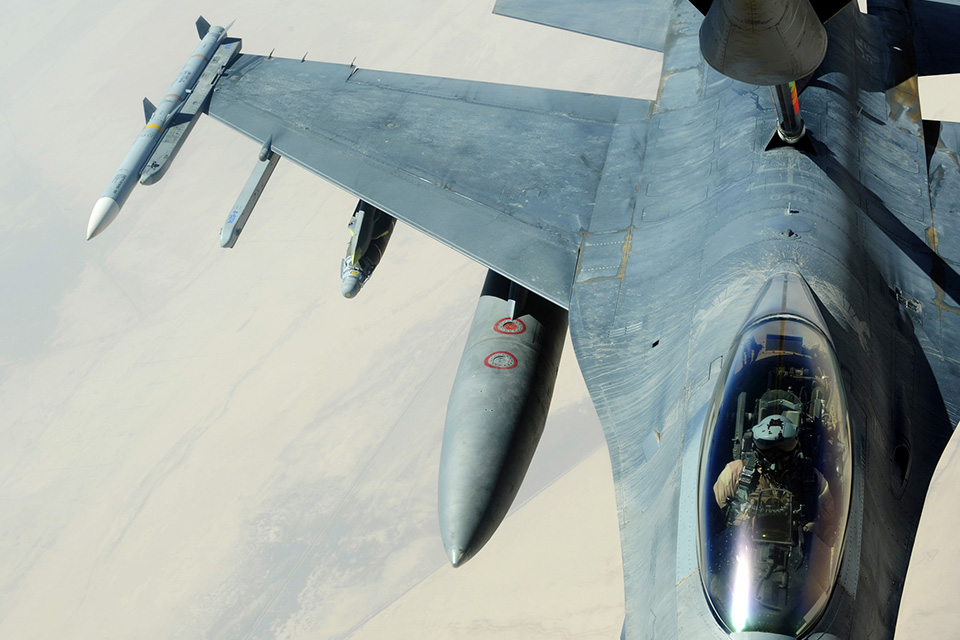
“BINGO…BINGO…BINGO…” The audible warning system, called Bitching Betty, also started screaming at me over my low-fuel state.
Then two of the trucks at the back of the convoy blew up. Zipping down the road at a bare 100 feet, I booted the rudder, rolled again and zoomed up to about 300 feet.
“Chieftain…Roman 75 is off to the south and west…vehicles burning. The column has stopped in place.”
“Roman…hit ’em again…hit…Rags are…” And he faded away again into crackling noise.
I knew I didn’t have enough fuel left to go all the way back out and re-attack as I’d just done. So when the front of the convoy passed off the left wing, I turned and locked my eyes to it, staring so hard that my eyes watered. As it began to disappear in the dark, blowing sand, I slammed the throttle forward, popped straight up, and rolled nearly inverted to the right. Using the 200 feet of altitude I’d gained, I sliced down toward the ground and the leading Iraqi vehicle. It was a Russian-made armored personnel carrier.
And it saw me, too.
Pulling the throttle back, I skidded sideways to line up, and the thing opened fire at me. A double line of green tracers arced off to my left and began correcting as the gunner got a better look at me.
I ignored it and rolled my wings level, letting the pipper come up to the target. I was close enough to see that the gunner wasn’t wearing a helmet and he had a mustache. As the pipper reached the front bumper of the APC, I squeezed the trigger again.
“BUURRRPPP.” The vehicle disappeared in a sudden fog of chewed-up dirt and sparks. As I pulled up and bunted over again, my eyes flicked to the rounds remaining counter and then to the radar altimeter. Fewer than 100 rounds left, and I was less than 140 feet above the ground.
There wasn’t time for finesse, so I just manhandled the pipper to the leading truck and opened fire for the last time.
“BUURRP.” And the gun shuddered to a stop as I passed through 50 feet.
Cranking up hard off to the west, I kicked the rudder to spoil anyone’s aim, pulled on the stick and looked over my right shoulder. Just then the truck exploded, shooting off thousands of rounds of ammunition, and I flinched reflexively. One cannon shell must’ve hit the next truck in line, because it blew up, too. As the ground vanished into the brown haze, I saw the remaining trucks and APCs sliding off the road into the ditch.
Swallowing several times to get some spit back in my throat, I selected the point for the Twitch refueling track and began a steady climb.
“Chieftain…Roman 75 is off to the west…Bingo…Winchester and RTB.”
That was the short way of saying I was leaving the target area, out of gas and weapons, and returning to base. But it didn’t matter, because he didn’t answer and I had other things to worry about now.
Seventeen hundred pounds of fuel.
I was so far below Bingo that I wasn’t sure I could reach the border, much less a forward-divert base in Kuwait. I felt the cold sweat drying on my skin as I safed up my weapons and eyeballed the engine gauges to make sure I hadn’t picked up a stray round or two.
Passing through 8,000 feet heading southwest toward the border, I broke into the clear. Not much in my life has looked better to me than that weak blue sky. Dropping my mask again, I wiped my stubbled chin and rubbed my eyes.
“Roman Two…One on Victor.” I keyed the mike and waited. No answer. I changed frequencies and tried the AWACS. “Luger…this is Roman 75.”
Again, no answer.
And now I had a decision to make. Maybe my last one. The tanker track was roughly 120 miles off my nose, but there was no guarantee I’d find a tanker there. Or, if I did, he might not have any gas to spare. In which case, I was screwed.
About the same distance off my left wing was Kuwait. There were several bases I could probably coast into and manage to land. But without talking to AWACS, I had no way of knowing which ones were open or in good enough shape for me to land. And then I was still screwed.
I’d now been strapped in a fighter cockpit for more than eight hours, and I’d refueled five times. I’d planned on a normal six-hour mission and hadn’t brought food or water. My butt hurt and my eyes ached. I turned the heat up because my sweat-soaked flight suit was making me shiver.
I’d flown more than 100 combat missions by the time this war began and was no novice in combat. I had a hatful of campaign ribbons and medals, including a Purple Heart, from earlier conflicts, and would later be awarded three Distinguished Flying Crosses with Valor. But that was all either in the past or the future. For right now, not far to the west, one of nature’s true nightmares was fast approaching. The khamsin, the sandstorm, was an ominous wave of dirt stretching north and south along the horizon as far as I could see. The sky above the storm was gone.
It was appalling.
The momentary relief I’d been feeling leaked out of me. A storm like that could ground every aircraft on the continent, and I realized maybe that was why I hadn’t heard from anyone. That was a nasty thought. Swallowing again, I passed 15,000 feet and stared out at the brown carpet stretching out before me. If I managed to get to 25,000 or 30,000 feet, I could glide to the border and at least eject over friendly territory.
It wasn’t over yet.
As he describes in his new book Viper Pilot, following the action over Nasiriyah Dan Hampton managed to hook up with a KC-135 tanker whose crew had bravely ventured into Iraq. He then landed safely in a driving duststorm at Ali al-Salem Air Base in Kuwait. Hampton retired in 2006 from the U.S. Air Force as a lieutenant colonel after 20 years of service, having logged 726 combat hours flown.
This feature appeared in the November 2012 issue of Aviation History. Subscribe here!

